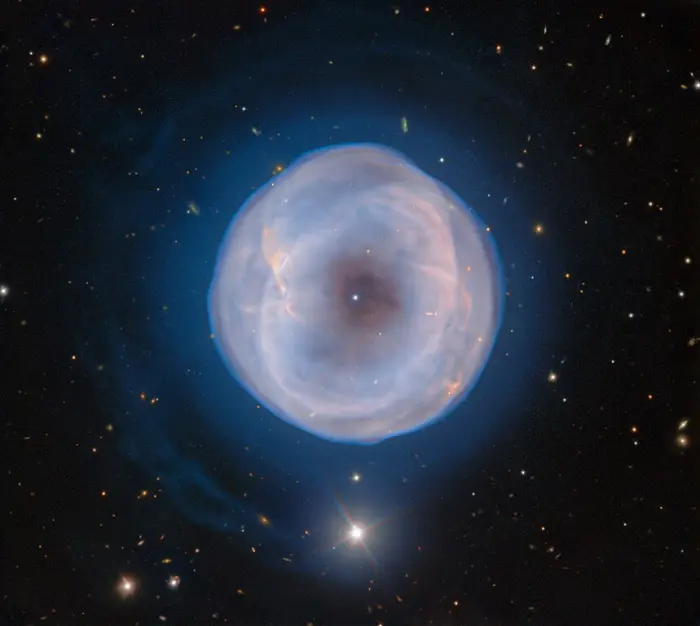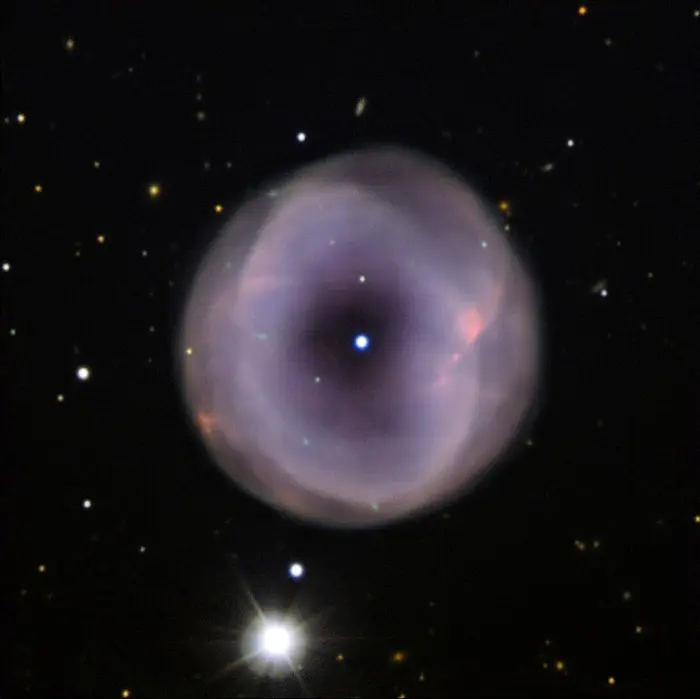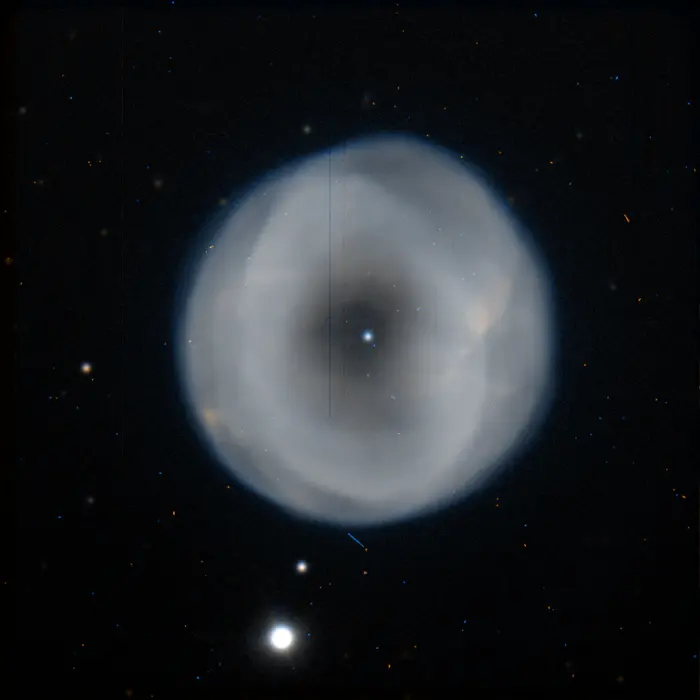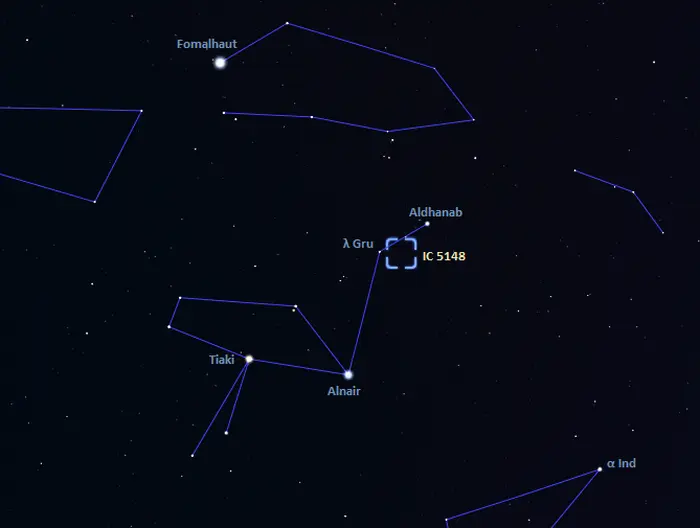The Spare Tyre Nebula is a planetary nebula located 3,000 light-years away in the southern constellation Grus (the Crane). It has an apparent magnitude of 16.5. It is listed as IC 5148 in the Index Catalogue.
IC 5148 appears 2 arcminutes across. It has a physical radius of 1.2 light-years (0.368 parsecs) and an expansion velocity of 53 km/h. It is one of the fastest expanding planetary nebulae known.
IC 5148 was nicknamed the Spare Tyre Nebula because it appears as a ring of material with a central cavity around the progenitor star. The bright ring is surrounded by a fainter halo about 6 arcminutes in diameter.

IC 5148, nicknamed the Spare Tyre Nebula, is a beautiful planetary nebula located about 3000 light-years away near the ‘neck’ of the southern constellation Grus (The Crane). This image, captured with the Gemini South telescope, one half of the International Gemini Observatory operated by NSF’s NOIRLab, showcases the looming cloud of gas of IC 1548 and the central stellar remnant from which the gas radiates. With small telescopes, this nebula looks like a bright central star with an outer ring. The mesmerizing layers of gas are faint. They are almost undetectable without the use of larger telescopes, and not with the clarity captured in this image using the Gemini Multi-Object Spectrograph (GMOS) on Gemini South. Around the time IC 5148 was discovered by astronomers in 1894, researchers coined the term planetary nebula to refer to these giant gaseous balls that looked like giant planets. Today we know that these balls are in fact stellar remnants. At the center of IC 5148 is a white dwarf, the hot core of the central star, surrounded by asymmetrical gaseous ‘blooms’ and a faint halo ring. The predecessor of the white dwarf was likely a star of a similar mass to our Sun. At the end of that star’s life, the internal pressure imbalance resulted in the star swelling up into a red giant. As it grew, the outer layers of the gas and stellar material were pushed into space to form the nebula we see today. The central hole — the dark patch surrounding the star — is due to the pressure of the radiation from the star that pushes the surrounding gas away from the core and leaves a vacant space. The formation of the ring and the bow-like structures of gas are marks of the evolutionary history of IC 5148 — but the mechanisms that created them remain a mystery to astronomers. Image credit: International Gemini Observatory/NOIRLab/NSF/AURA Image processing: T.A. Rector (University of Alaska Anchorage/NSF’s NOIRLab), J. Miller (Gemini Observatory/NSF’s NOIRLab), M. Rodriguez (Gemini Observatory/NSF’s NOIRLab), & M. Zamani (NSF’s NOIRLab) (CC BY 4.0)
The halo is composed of material expelled from the star during an earlier stage of its evolution, while the star was on the asymptotic giant branch (AGB). The complex structure of rings and bow-like structures was created as the star periodically expelled material in the final stages of its life.
Like all planetary nebulae, the Spare Tyre Nebula formed when an intermediate-mass star – an evolved red giant – reached a late stage in its evolutionary cycle and expelled its outer layers. The expelled gaseous envelope is now excited by the radiation of the hot stellar remnant. The ionizing light of the remnant star makes the expelled material glow as a bright planetary nebula.
The remnant core of the progenitor star will eventually cool and its radiation will not be sufficient to illuminate the expanding nebula. The clouds of ejected material will disperse into the interstellar medium and the central star will continue to fade as a white dwarf for billions of years.
The Spare Tyre Nebula has a kinematic age of 4,500 years and an evolutionary age of 71,590 years. It has a mass of 1.122 solar masses. These properties were derived in a 2021 study based on the data obtained in the Gaia Early Data Release 3 (Gaia EDR3).
The nebula’s central star has a spectral type of hgO(H), indicating a hydrogen-rich high gravity star with broad Balmer absorption lines. It was given this classification by Mendez in 1991.
The intense radiation of the hot star is responsible for pushing the surrounding gas away and carving out a cavity in the centre of the nebula. The central star was first revealed to be evolved and very hot during observations with the International Ultraviolet Explorer (IUE) carried out by Kaler and Feibelman in the 1980s.
In 2018, observations with the FORS2 (FOcal Reducer/low dispersion Spectrograph 2) instrument on the Very Large Telescope (VLT) in the Atacama Desert of northern Chile revealed that the nebula’s outer halo was highly ionized. A team of astronomers led by Daniela Barría of the Instituto de Astronomía, Universidad Católica del Norte, Chile, also detected gas outflows beyond the hot ionized halo. The astronomers estimated an initial mass of 1.5 solar masses and for the progenitor star.

IC 5148 is a beautiful planetary nebula located some 3000 light-years away in the constellation of Grus (The Crane). The nebula has a diameter of a couple of light-years, and it is still growing at over 50 kilometres per second — one of the fastest expanding planetary nebulae known. The term “planetary nebula” arose in the 19th century, when the first observations of such objects — through the small telescopes available at the time — looked somewhat like giant planets. However, the true nature of planetary nebulae is quite different. Image credit: European Southern Observatory (CC BY 2.0)
Facts
The Spare Tyre Nebula has two listings in the Index Catalogue, IC 5148 and IC 5150. IC 5148 is more commonly used.
The nebula was discovered by the Australian amateur astronomer Walter Frederick Gale on June 4, 1894. After Gale’s discovery, the nebula was listed as IC 5150 in the Index Catalogue.
The catalogue designation IC 5148 was given to the nebula after it was independently discovered by the American astronomer Lewis Swift on July 23, 1897. IC 5150 and IC 5148 were identified as the same object by C. Hoffmeister in 1961.

IC 5148, based on observations made with ESO Telescopes at the La Silla Paranal Observatory under programme ID 184.C-1143(B) (CC BY 4.0)
Location
The Spare Tyre Nebula lies in the neck of the celestial Crane (Grus), about a degree west of the K-type giant Lambda Gruis (mag. 4.47). Lambda Gruis appears near the brighter Aldhanab (Gamma Gruis, mag. 3.0). The nebula can be found roughly halfway between the bright Fomalhaut in Piscis Austrinus and Alpha Indi in Indus.
In small telescopes, IC 5148 appears as a faint ring surrounding the bright central star. The intricate asymmetrical layers of gas can only be seen in larger telescopes at high magnification. The nebula is best observed with an OIII filter.

The location of the Spare Tyre Nebula (IC 5148), image: Stellarium
At declination -39° 23’, IC 5148 never rises for observers in locations north of the latitude 50° N.
The best time of the year to see the Spare Tyre Nebula and other deep sky objects in Grus is during the month of October, when the constellation appears higher above the horizon in the early evening.
Spare Tyre Nebula – IC 5148
| Constellation | Grus |
| Object type | Planetary nebula |
| Right ascension | 21h 59m 35.0865352632s |
| Declination | −39° 23′ 08.233040148″ |
| Apparent magnitude | 16.5 |
| Apparent size | 2’ x 2’ |
| Distance | 3,000 light-years (920 parsecs) |
| Radius | 1.2 light-years (0.368 parsecs) |
| Names and designations | Spare Tyre Nebula, IC 5148, IC 5150, ESO 344-5, PN G002.7-52.4, PK 002-52 1, IRAS 21565-3937, PSCz P21565-3937, GALEX J215935.0-392307, GALEX J215935.0-392308, Gaia DR2 6574225217863069056, Gaia DR3 6574225217863069056 |